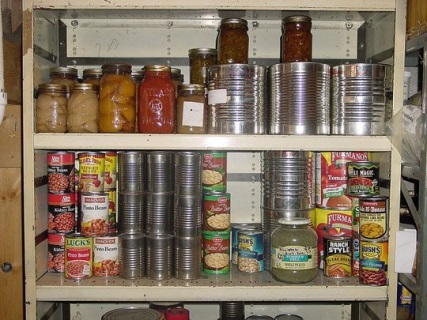How To Start a Food Storage Plan On $10 A Week
In my house we keep a storage of food and water that will last two people a full year. It might sound “apocalyptical” but in all reality, all it means is we’re ready for whatever life has to throw at us. You can start your own food storage (even if it’s not a year’s worth) for as little as $10 a week. Want to see how?
Now I know many of you are saying to yourself, “A year’s worth of food, are they crazy?” and the long and the short of it is no. Over the last 13 years my husband and I have fought alongside of the ups and downs of the economy. We’ve moved more times than I can count, gone through job losses, natural disasters and city boiling orders. We’ve been sick and paychecks have been short and we’ve had to spend extra saved cash on things like medical bills or emergency home improvements.
By having a supply of food it means we can go without making trips to the store if we don’t need to. Plus, the more you focus on eating from your pantry, the more time you spend at home with family, enjoying home-cooked meals, and what can be better than that right?
Starting your own food storage stash isn’t difficult; in fact it’s as simple as picking up a few extra things each time you head to the store. No one is going to the store and coming back with 500 cans of black beans, so don’t worry about looking like the crazy person at the grocer — and if a year’s supply seems extreme, shoot for 3 months instead! Here are a few steps to guide you through the process:
Instructions
1. Determine What You Eat
This sounds silly, but in your food stash, you don’t really want things you don’t eat. Just because one person wants 12 gallons of powdered orange drink doesn’t mean you need to acquire it if it’s not something your family uses.
Make a list of meals. Any meal. Obviously as new recipes come up you’ll want to add those things to the continual list, but make a list of things you eat and the ingredients that go into them. From there you can determine what you’ll actually be after the most when you hit the grocery stores.
2. Determine How Much You Need
Now that you know what you need to stock up on, how do you know how much your family will really consume. There are two options. One is specific and the other is a bit more general (it just depends on what kind of cook you are).
• Add It Up: Let’s say your family would like to eat lasagna once a month, for 12 months. Simply add up the ingredients in the recipe and add it to the list. Do the same for all other recipes to give you a master list of ingredients and combine where needed. It will look huge, that’s ok.
• Average It Out: There are websites geared to help you determine how much of what type of ingredients and supplies you need to have on hand for a specific number of months for survival. You probably won’t find ricotta cheese on the list (like the one above), but you will find the total number in pounds you need of beans, rice and meats. We like this one. Simply enter your family members up top and scroll down slightly to see the amounts you’ll need to shoot for acquiring.
3. So How Do I Do This For $10 A Month?
Although the task of acquiring a years worth of food seems insurmountable, the key is to start small. Each week you’ll pick up what you can (watching for sales never hurt anyone) and roll over any spare change (Even if it’s literal pennies) to the next week’s stash. One week you might pick up 3 cans of tuna, some rice, a few cans of olives and several bags of dry beans and although that doesn’t in itself make a meal, it does make good use of the $10. Here’s an example of what a first month could look like and although boring, the next month might bring variety and new things!
Watching for sales on dried pasta, beans and other basic pantry staples can be a huge help. Watch for these sales around the holidays (4th of July, Labor Day). If there isn’t anything spectacular on sale one week, it’s ok to save that week’s money until the next week if you know you have something large to buy (say meat for the freezer).
4. Do You Can?
So you picked up 200lbs of brown rice on a sweet deal, but how do you keep it from going bad? Dry pack canning or storing grains in large food safe barrels is the easiest method. Either works depending on where you’ll be storing your food. In smaller homes you might find dry milk packed under the bed or sofa while in a large home with a basement you’ll find large barrels back in the corner. Check here for more information about dry pack canning and here in our archives for wet canning at home (hello fresh garden tomatoes!).
5. Freeze It!
For those that have the space, freezing meals in either individual portions like what’s pictured here or in full pan size portions is a great way to have meals on hand using ingredients from your food storage. You’ll probably order out for pizza when all you see is a sea of wheat, but if you see lasagna you probably know exactly what’s in store for the nightly meal!
6. Don’t Forget To Date
When you bring home or pack up items for your food storage, it’s important to live by the philosophy of the first in is the first out. This will help you use up the oldest items in your food storage first. Just use a black permanent marker to make note of the date on top of the can. This will eliminate the question of “How long has this been in here?” and allow you to utilize all your food without waste.
7. Where Do You Keep It?
So you have a small apartment and don’t even have room to store your winter coat let alone a few months worth of extra food. You have a compact refrigerator and have one lone cabinet — so where do you keep it all? Well usually it’s time to get creative. In the past we’ve met people who keep things under furniture in additional closets throughout the home or potentially in a basement storage space in an apartment complex. Wherever you chose, just make sure the space is clean, dry and low in humidity if possible!
Survival MD (Best Post Collapse First Aid Survival Guide Ever)
Backyard Innovator (A Self Sustaining Source Of Fresh Meat,Vegetables And Clean Drinking Water)
Blackout USA (EMP survival and preparedness)
Conquering the coming collapse (Financial advice and preparedness )
Liberty Generator (Build and make your own energy source)
Backyard Liberty (Easy and cheap DIY Aquaponic system to grow your organic and living food bank)
Bullet Proof Home (A Prepper’s Guide in Safeguarding a Home )
Family Self Defense (Best Self Defense Strategies For You And Your Family)
Sold Out After Crisis (Best 37 Items To Hoard For A Long Term Crisis)
SOURCE : www.thekitchn.com




In you article how to start a food storage plan on 10$ a week,you reference different places to get things saying go here but there are no links included. Is this because I’m on mobile? Love the article by the way!